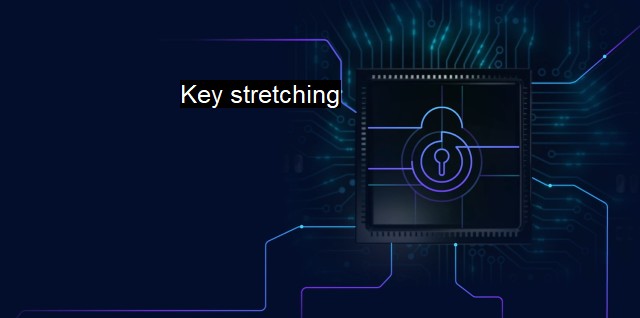What is Key stretching?
Key Stretching: Enhancing Password Strength in Cybersecurity
Key stretching is a mechanism used in the field of cybersecurity that involves cryptologically enhancing a password to minimize potential threats and vulnerabilities. This technique typically involves a transformation of the original password with a cryptographic algorithm, bolstering it against more powerful attacks, like brute-force. The central goal of key stretching is to make the password hardened thus making it harder for cybercriminals to break.Key stretching emerged due to the perceived need to mitigating potential threats of weak passwords. Weak passwords are easy targets for cybercriminals in decoding the hash values stored in databases. They take a limited amount of time to crack due to the low number of potential combinations, and the proliferation of high-speed computation has only made brute force attacks more common. Key stretching acts as a countermeasure, creating an intentional slowdown that increases complexity and deters hackers.
It's worth noting that key stretching doesn't change the password itself. Rather, it augments the process of password hashing. Hashing involves converting plaintext passwords into random strings of characters. It's a one-way procedure, whereby the same password, when hashed, will always produce the same hashed code, but the hashed code cannot be reversed to reveal the original password.
Key stretching derives from the standard concept of hashing. The main difference is that instead of hash values being quickly generated, the key stretching method slows down the creation process considerably, by repeatedly hashing each password hundreds or even thousands of times. This graduated delay makes brute-force attacks impractical because they have to compute every password's hashes for every possible salt value, which is computationally resource-intensive.
A common key stretching technique used is Password-Based Key Derivation Function 2 (PBKDF2). This method significantly increases the computational requirements of password cracking and relies on the use of a pseudo-random function and iterations to hash a password. To further beef up the security, a process called "salting" is used, adding a random data to the input of the hash function.
Another commonly used key stretching Algorithm is the Bcrypt algorithm, which uses the Blowfish cipher to hash the password. This is known for its flexibility and enhanced security, primarily because the number of rounds it does is configurable, making it easier for system administrators to determine the desired level of protection.
Scrypt is also another advanced key stretching algorithm that isn't just computationally intensive but also requires a lot of memory. This unique feature makes it resistant to hardware attacks because it is both time-consuming and expensive to perform a successful attack.
In the context of antivirus and online protections, key stretching is essentially an extra layer of security. By raising the cost and time needed to crack a password hash, it serves to deter potential attackers. Many modern antivirus solutions include key stretching techniques as part of their comprehensive protections, making it far more difficult for attackers to gain unauthorized access. In this way, key stretching can prevent unauthorized access, data theft and maintain the integrity of data.
Nonetheless, key stretching is not a silver bullet to all security issues. It works best when used in conjunction with other security practices such as strong unique passwords, multi-factor authentication, and regular software updates. It offers an added layer of security that can drastically minimize your vulnerability to password-related attacks.
Key stretching plays a crucial role in current cybersecurity practices. It proves its effectiveness directly against brute-force and dictionary attacks by requiring increased computational resources, thereby tackling a key weakness in many security strategies. Combined with other security procedures, it forms a robust defense against cyber threats.

Key stretching FAQs
What is key stretching in cybersecurity?
Key stretching is a process used in cybersecurity to enhance the strength of a cryptographic key. It involves adding additional complexity to the key through the use of algorithms or hashing functions, making it more difficult to be cracked by attackers.Why is key stretching important for antivirus protection?
Key stretching is important for antivirus protection because it helps to prevent attackers from accessing sensitive information by making it more difficult to decrypt. By stretching the encryption key, it increases the amount of time and resources an attacker would need to crack the key, providing an additional layer of security.What are some common key stretching algorithms used in cybersecurity?
There are several common key stretching algorithms used in cybersecurity, including bcrypt, PBKDF2, and scrypt. These algorithms increase the number of iterations required to generate the key, making it more difficult to crack the encryption.Is key stretching enough to provide complete protection for sensitive data?
Key stretching is an important component of cybersecurity and can significantly increase the strength of cryptographic keys. However, it is not enough on its own to provide complete protection for sensitive data. Other security measures like access control, firewalls, and intrusion prevention systems should also be implemented to ensure comprehensive protection.| | A | | | B | | | C | | | D | | | E | | | F | | | G | | | H | | | I | | | J | | | K | | | L | | | M | |
| | N | | | O | | | P | | | Q | | | R | | | S | | | T | | | U | | | V | | | W | | | X | | | Y | | | Z | |
| | 1 | | | 2 | | | 3 | | | 4 | | | 7 | | | 8 | | |||||||